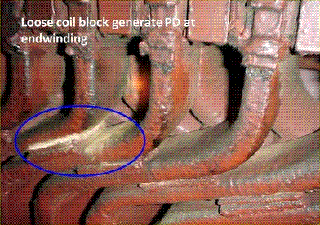
The ionization test is used primarily for detecting ionization (corona discharge) and slot discharge in generator windings. Both ionization and slot discharge may cause deterioration of insulation. Ionization generally occurs in voids inside the insulation within the ground shield section of the coil. Some internal ionization is present in most higher voltage stator insulation.
If it is intense enough, it produces destruction of the binder and other organic components by the chemical effects of the ozone and oxides of nitrogen generated by the discharge (plus moisture) and eventually by direct electronic bombardment. Destruction is often aggravated finally by mechanical vibration of the conductors where the insulation has been softened by the other effects.
Slot discharge is a capacitance discharge and occurs across poor contact points between the coil surface shielding and the stator iron. Deterioration is from the destructive effect of this relatively concentrated discharge. Coils which fit loosely in the slots may be subjected to this trouble.
Test apparatus for corona detection requires much higher sensitivity than detection of slot discharge.
Test Methods for Slot Discharge
A method used for detecting slot discharge in AC generator windings consists of energizing the winding from a high-potential AC test set at voltages of approximately 50 to 125 percent of normal rated machine voltage or running the unit self excited and isolated from the system and observing on an oscilloscope the resulting induced potentials from slot dis-charges.
The detecting apparatus is coupled through a condenser to the terminal of the winding being tested or to a probe which is placed ill contact with the stator coil shielding. With the oscilloscope sweep set for one-half the applied frequency, the characteristic hash indication appears at two or four places along the sweep since the discharge occurs at particular parts of the voltage cycle.
Because the detector cannot distinguish between hash originating in the winding and that originating in the power source, it is essential that the stator winding be energized from a good high-potential test set or a transformer operated well below its rated voltage.
Voltage of about 50 percent, normal or below which no corona occurs, is first applied as a calibration point or base. The voltage is gradually raised until there is distinct change in the hash on the oscilloscope screen.
This is the point where slot discharge is considered to begin. A winding properly protected from slot discharge should not produce hash at voltages below approximately 125 percent of normal. Experience and special calibration apparatus are necessary in order to properly interpret the results.
SOURCE: Testing solid insulation of electrical equipment – Facilities engineering branch Denver office Denver, Colorado










